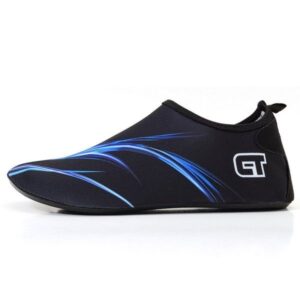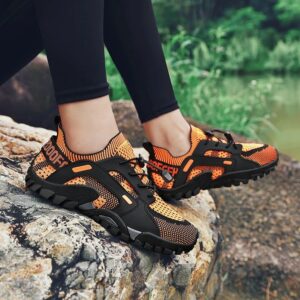Barefoot shoes mens aim to give one the experience of walking barefoot but with some protection to the feet. The shoes are made in a minimalist design; thin, flexible soles that will allow one to feel the ground and help them strengthen their feet by improving balance. The best fit for people who want to feel more natural when it comes to running and walking.

barefoot-shoes-mens
Table of content
- Types of Barefoot Shoes
- Key Features of Barefoot Shoes
- Choosing the Right Barefoot Shoes
- Caring for Barefoot Shoes
- Popular Brands and Models
Types of Barefoot Shoes
Minimalist Running Shoes
Minimalist running shoes are designed for people who like to run with a natural feeling. Very thin soles can allow you to feel the ground and improve running posture. Lightweight design with a flexible sole is what you should look out for. Be sure they fit just right, which will impede any kind of discomfort while running.
Casual Barefoot Shoes
Barefoot casual shoes are ideal in everyday occasions. The shoes are rather designed in a simple way to give you the feeling of walking barefoot but still in style. Such barefoot shoes can perfectly fit for walking in town or just lounging around the house. Find those made of breathable material to keep your feet comfortable throughout the day.
Hiking Barefoot Shoes
Outdoor hiking barefoot shoes are meant for rough outdoor terrain. The sole is more rugged and stronger compared to the other varieties of barefoot shoes. Therefore, they are better protective against rocks and sharp surfaces. Additional grip on the soles will provide extra security and comfort throughout your walks.
Water Barefoot Shoes
These shoes are meant for wet conditions, like beaches or rivers. Most of them are made from quick-drying material and have drainage holes so that water leaks out easily.
Key Features of Barefoot Shoes
Flexibility
This allows your feet to ‘get a grip’ on the ground, balancing and strengthening them in the process. In regard to selecting barefoot shoes, ensure that their soles bend and twist easily for full flexibility.
Minimum Cushioning
Most of these shoes have very minimal cushioning or no cushioning at all, allowing one to feel the ground. In turn, the use of minimum cushioning supports natural/organic form during walking or running.
Wide Toe Box
The wide toe box provides a naturally spreading of the toes, and room enough in the toe area to avoid any pinching and crowding of toes inside. This aids in avoiding discomforts from occurring and lets your foot function as it would when barefooted.
Lightweight Design
Barefoot shoes need to be light because that allows you to connect with the ground and reduce the impacts on your legs. A lightweight design will also provide comfort during long usage. Check that the shoes feel light and are easy to move in for the best from their natural feel.
Choosing the Right Barefoot Shoes
Purpose and Activity
Consider what you will be using these barefoot shoes for. If you want to run with them, then get the minimalist running shoes with the characteristics of flexibility and lightness. For casual days, wear casual barefoot shoes that are comfortable yet stylish. For hiking, go for rugged hiking barefoot shoes that have tougher soles. In water, wear water barefoot shoes that can dry off fast.
Fit and Sizing
Barefoot shoes should not be too tight but rather fit comfortably. The toe box must have enough room to accommodate your toes so they can splay naturally.
Material and Durability
Generally speaking, the more flexible and breathable the materials, the better they are for comfort and natural motion. If you will be working on uneven or wet ground, be sure to choose shoes that have heavy-duty material or quick-drying material. Check customer reviews or the product description to get an idea of whether your shoes will last with time and hold up to the intended use.
Caring for Barefoot Shoes

barefoot-shoes-mens
Cleaning Tips
Cleaning your barefoot shoes should start with a damp cloth to remove dirt and grime. When you need to give them a deeper clean, mild soap and water will work well, but avoid soaking them. If your shoes are machine washable, follow instructions given by the manufacturer. Allow them to air dry, since direct heat can damage the materials.
Storage Advice
Store your barefoot shoes in a cool, dry place away from direct sunlight to prevent damage to the materials. Never allow them to stay in damp or humid areas since this will likely lead to odors or mold within the shoe. Therefore, to maintain the shape, use trees or stuff the inside with paper.
Repairing Small Damages
If there are small tears or scuffs, use a fabric repair kit or adhesive designed for shoes. For problems relating to the sole, like peeling or separation, apply a strong, flexible shoe glue. If the damage is extensive, consider taking them to a professional shoe repair shop to extend their life.
Popular Brands and Models
Overview of Leading Brands
Several brands have shared a good reputation concerning barefoot shoes. Vibram FiveFingers is remarkable for its signature toe and natural feel, hence setting them apart to provide unique experiences in barefoot shoes. Vivobarefoot sells a range of stylish and durable barefoot shoes intended for different activities. Merrell has mixed the barefoot feature with robust designs, especially in hiking shoes.
Notable Models and Their Features
The Vibram FiveFingers KSO boasts class-leading separated toe pockets, which provide excellent ground feel and flexibility, hence fit for running and casual wear. The Vivobarefoot Primus Lite is a lightweight, airy, minimally designed shoe intended for everyday use and light exercise. Full of freshness, the Merrell Vapor Glove provides a close-to-barefoot feel and added durability for running and outdoor activities.
FAQ on barefoot shoes mens
What are general benefits from barefoot shoes?
Barefoot shoes allow your feet to move and flex in a natural way, as if they were without shoes; this assures a more natural way of walking and running. They may help improve balance, strengthen foot muscles, and also enhance one’s sense of the ground. Many find that barefoot shoes reduce the risk of some types of injuries because these shoes encourage a more natural gait.
How do I choose a proper size for barefoot shoes?
First, take a measurement of your foot and match it against the size chart for that brand. After all, sizes can vary between manufacturers. Barefoot shoes should be worn neither too loose nor too tight but just comfortably, where there is space in the toe box for toes to spread naturally. Likewise, try on shoes during the end of the day when feet are slightly swollen to guarantee comfort.
Can barefoot shoes be used for any type of activity?
If you want to run in them, choose minimalist running shoes. If you want to use them outdoors and casually, select the stylish and comfortable everyday shoes. In case of hiking or planning to be around water, take the ones that have additional durability in their build or quick-drying features.
If I usually wear classic shoes, how should I switch to barefoot shoes?
Switching to barefoot shoes means you need to give your feet some time to adapt to them. Start with low-impact activities and add some strengthening exercises of the muscles of the foot to help make sure that you minimize the risk of injury.
How to care for my barefoot shoes?
Wipe your barefoot shoes with a damp cloth regularly. If they need washing, proceed with mild soap and cold water. Do not soak; let them completely dry out with the air. Store in a cool, dry place, away from direct sunlight. .
Conclusion
Barefoot shoes provide the wearer with a shoe that is flexible, allows for minimal cushioning, provides room for the toes in a wide toe box, and is lightweight. Consider use, fit, and material in selecting the proper pair.
Source by: https://images.app.goo.gl/MFS52vrMSptxRMNX6
https://images.app.goo.gl/sW4d5QjX1pcBcixJ6
Writtern by: Bioleather.in
